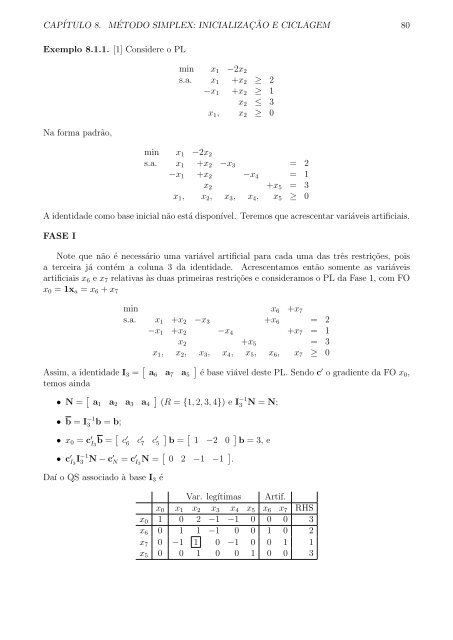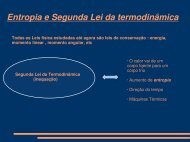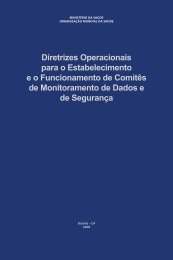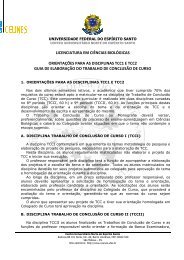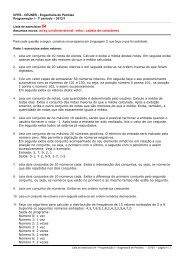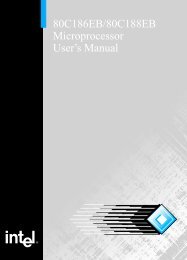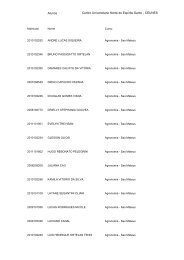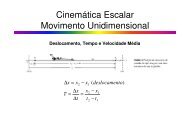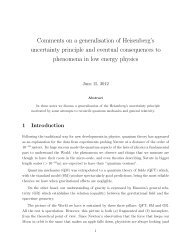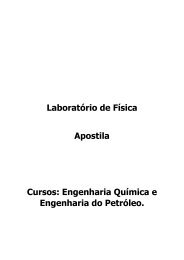CAPÍTULO 8. MÉTODO SIMPLEX: INICIALIZAÇÃO E CICLAGEM 79on<strong>de</strong> A é m × n com posto m. Po<strong>de</strong>mos supor sem perda <strong>de</strong> generalida<strong>de</strong> que b ≥ 0 poispo<strong>de</strong>mos manipular facilmente as restrições para que isso ocorra. O sistema Ax = b admitesolução se, e somente se, o sistema Ax + x a = b, x a = 0 admite solução, ou seja, o PL(7.1) é viável se, e somente se, pu<strong>de</strong>rmos ter x a = 0 e x ≥ 0. Agora observe que o últimosistema contém um bloco I m , relativo às variáveis artificiais x a . Proce<strong>de</strong>mos então como segue.Primeiro acrescentamos variáveis artificiais <strong>de</strong> modo a obter o bloco i<strong>de</strong>ntida<strong>de</strong>. A fim <strong>de</strong> testarse o PL (7.1) é viável <strong>de</strong>vemos verificar se po<strong>de</strong>mos ter x a = 0 e x ≥ 0, ou equivalentemente,se o PLmin 1x as.a. Ax + x a = bx ≥ 0x a ≥ 0on<strong>de</strong> 1 é vetor <strong>de</strong> uns, tem solução ótima com FO x 0 = 1 × 0 = 0. Note que este PL é viávelpois x = 0, x a = b ≥ 0 é uma solução sua. Mais ainda, este po<strong>de</strong> ser resolvido pelo Simplexinicializado pela base viável I m . Após resolvido, teremos uma base B formada por colunas damatriz [ ]A I m . Se na otimalida<strong>de</strong> <strong>de</strong>ste PL temos a FO x0 = 0 e todas as variáveis artificiaisfora da base, então as variáveis artificiais x a serão VNB’s, enquanto as VB’s serão variáveislegítimas x B do PL original. Portanto a base viável final B é formada somente <strong>de</strong> colunas damatriz original A, e logo o Simplex para o PL original po<strong>de</strong> ser inicializado com esta base. Esteé o Método <strong>de</strong> Duas Fases.O esquema a seguir resume o Método <strong>de</strong> Duas Fases no caso discutido.1. (FASE I) Resolva o PLmin 1x as.a. Ax + x a = bx ≥ 0x a ≥ 0pelo Simplex, inicializado com a solução básica viável x = 0, x a = b (relativa à base I m ,formato pelas m últimas colunas <strong>de</strong> [ A I m]).Se na otimalida<strong>de</strong> x a ≠ 0, então pare com a conclusão <strong>de</strong> que o problema original éinviável. Caso contrário, a base viável corrente B é formada somente <strong>de</strong> colunas <strong>de</strong> A(assumimos por hora que todas as variáveis artificiais saem da base). Seja x B as VB’slegítimas relativas à base B e x N as VNB’s legítimas. Passe para o próximo passo.2. (FASE II) Resolva o PL original pelo Simplex inicializado com a solução básica viávelx B = B −1 b, x N = 0, ou seja, resolva o PLmin c B x B + c N x Ns.a. x B + B −1 Nx N = B −1 bx B , x N ≥ 0Ativida<strong>de</strong> 22. Como já dito, o problema da Fase 1 do Método <strong>de</strong> Duas Fases é viável. Mostreque ele não é ilimitado, e por isso a Fase 1 é coerente.Po<strong>de</strong> ocorrer que na otimalida<strong>de</strong> do PL da Fase 1, tenhamos x a = 0 mas alguma variávelartificial x ai = 0 é VB. Por <strong>de</strong>finição, isso significa que a solução ótima do PL da primeira faseé <strong>de</strong>generada. Ora, neste caso a base da Fase 1 tem pelo menos uma coluna relativa à variávelartificial x ai , e não po<strong>de</strong> ser utilizada no PL original. Veremos adiante como proce<strong>de</strong>r nessecaso.
CAPÍTULO 8. MÉTODO SIMPLEX: INICIALIZAÇÃO E CICLAGEM 80Exemplo 8.1.1. [1] Consi<strong>de</strong>re o PLNa forma padrão,min x 1 −2x 2s.a. x 1 +x 2 ≥ 2−x 1 +x 2 ≥ 1x 2 ≤ 3x 1 , x 2 ≥ 0min x 1 −2x 2s.a. x 1 +x 2 −x 3 = 2−x 1 +x 2 −x 4 = 1x 2 +x 5 = 3x 1 , x 2 , x 3 , x 4 , x 5 ≥ 0A i<strong>de</strong>ntida<strong>de</strong> como base inicial não está disponível. Teremos que acrescentar variáveis artificiais.FASE INote que não é necessário uma variável artificial para cada uma das três restrições, poisa terceira já contém a coluna 3 da i<strong>de</strong>ntida<strong>de</strong>. Acrescentamos então somente as variáveisartificiais x 6 e x 7 relativas às duas primeiras restrições e consi<strong>de</strong>ramos o PL da Fase 1, com FOx 0 = 1x a = x 6 + x 7min x 6 +x 7s.a. x 1 +x 2 −x 3 +x 6 = 2−x 1 +x 2 −x 4 +x 7 = 1x 2 +x 5 = 3x 1 , x 2 , x 3 , x 4 , x 5 , x 6 , x 7 ≥ 0Assim, a i<strong>de</strong>ntida<strong>de</strong> I 3 = [ a 6 a 7]a 5 é base viável <strong>de</strong>ste PL. Sendo c ′ o gradiente da FO x 0 ,temos ainda• N = [ a 1 a 2 a 3 a 4](R = {1, 2, 3, 4}) e I−13 N = N;• b = I −13 b = b;• x 0 = c ′ I 3b = [ c ′ 6 c ′ 7 c ′ 5]b =[1 −2 0]b = 3, e• c ′ I 3I −13 N − c ′ N = c′ I 3N = [ 0 2 −1 −1 ] .Daí o QS associado à base I 3 éVar. legítimas Artif.x 0 x 1 x 2 x 3 x 4 x 5 x 6 x 7 RHSx 0 1 0 2 −1 −1 0 0 0 3x 6 0 1 1 −1 0 0 1 0 2x 7 0 −1 1 0 −1 0 0 1 1x 5 0 0 1 0 0 1 0 0 3


